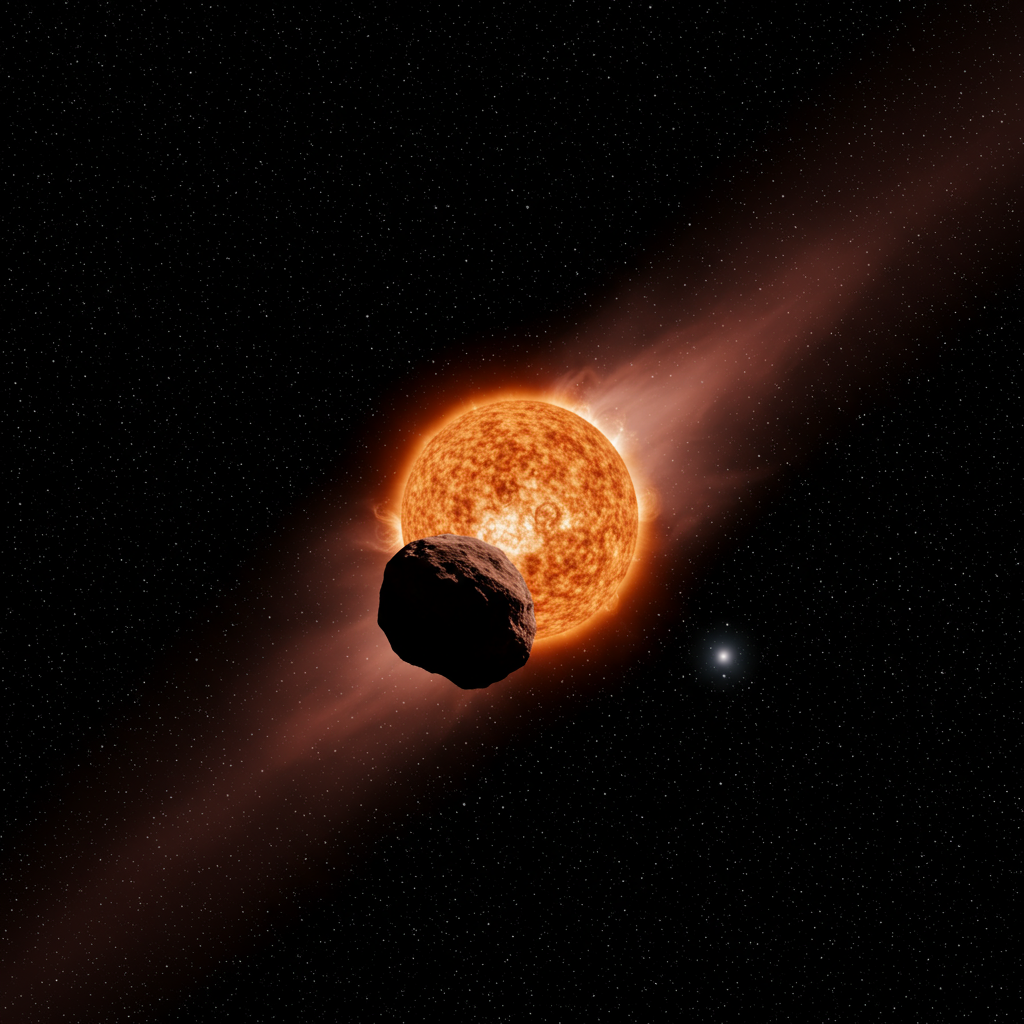An unprecedented visitor from deep space, interstellar comet 3I/ATLAS, is set for a dramatic close encounter with our Sun on October 30, 2025. While Earth-bound observers will miss this spectacular event, a dedicated armada of robotic explorers across our solar system is poised to capture invaluable data. This rare perihelion passage offers scientists a unique opportunity to study an object born in another star system, providing crucial insights into cosmic chemistry and the origins of other worlds.
Unveiling a Cosmic Interloper: What is 3I/ATLAS?
First detected by the NASA-funded Asteroid Terrestrial-impact Last Alert System (ATLAS), 3I/ATLAS is only the third confirmed interstellar object known to have entered our solar system. Its “3I” designation confirms its status as the third “interstellar” visitor, following 1I/’Oumuamua and 2I/Borisov. Unlike objects bound by the Sun’s gravity, this cosmic wanderer follows a hyperbolic orbit, meaning it’s merely passing through before heading back into the vastness of interstellar space.
Scientists have classified 3I/ATLAS as a comet due to its telltale characteristics. It displays an active state, features an icy nucleus, and forms a bright cloud of gas and dust—a coma—that expands as it heats up near the Sun. This distinguishes it from ‘Oumuamua, which showed no cometary activity. Initial observations suggest 3I/ATLAS is moving at an astonishing 60 kilometers per second (130,000 miles per hour), significantly faster than its interstellar predecessors. Its estimated age, potentially between 3 and 11 billion years, makes it a remarkably ancient visitor, offering a rare window into the early history of galaxies.
The Dynamics of Perihelion: A Comet’s Awakening
Perihelion marks the point in an object’s orbit where it comes closest to the Sun. For comets, this is a critical and often dramatic phase. As 3I/ATLAS nears our star, the increasing warmth causes volatile ices on its surface to sublimate. This process of outgassing creates the characteristic coma around its nucleus.
During this heightened activity, comets often sprout two distinct tails: a dust tail and an ion tail. The dust tail forms from heavier particles pushed away by solar radiation pressure. The ion tail, comprised of charged particles, is stripped away by the Sun’s powerful solar wind, always pointing directly away from the Sun. This increased activity makes the comet significantly brighter and more observable, with peak outgassing expected around perihelion. For 3I/ATLAS, this crucial moment occurs on October 30, 2025, when it will be approximately 1.35 astronomical units (125 million miles or 202 million kilometers) from the Sun.
Earth’s Blind Spot: Why We Won’t See the Spectacle
Unfortunately, for skywatchers and astronomers on Earth, the interstellar comet will be invisible during its peak activity. 3I/ATLAS entered solar conjunction in late September. This means it has moved behind the Sun from Earth’s perspective, becoming lost in the Sun’s overwhelming glare. Ground-based telescopes, as well as those in Earth orbit or at the L2 Lagrange point, will therefore miss this pivotal perihelion passage. The comet isn’t expected to reappear in Earth’s morning sky until late November or early December 2025.
However, this doesn’t mean the event will go unobserved. Far from it, a sophisticated network of spacecraft scattered throughout our solar system has been strategically positioned to capture this extraordinary event.
Eyes Across the Solar System: Our Robotic Witnesses
A flotilla of interplanetary probes offers scientists a privileged view of 3I/ATLAS. Missions currently orbiting Mars, for example, have an excellent vantage point. They already had a ringside seat for the comet’s closest approach to the Red Planet on October 3, 2025, passing at a distance of 0.19 AU (17.6 million miles). These Mars orbiters, including ESA’s Mars Express and ExoMars Trace Gas Orbiter, are well-positioned to monitor the comet as it rounds the Sun’s hemisphere.
Beyond Mars, other spacecraft are joining the observation campaign:
NASA’s Psyche mission, en route to the metallic asteroid Psyche.
NASA’s Lucy mission, targeting Jupiter’s Trojan asteroids.
- The European Space Agency’s Jupiter Icy moons Explorer (JUICE) probe will be one of the closest observers. JUICE, which recently completed a Venus flyby, is heading towards the Jovian system. A key limitation for JUICE, however, is that its primary antenna is currently used as a sun-shield. This means data from its observations of 3I/ATLAS won’t be transmitted back to Earth until February 2026.
- www.space.com
- www.space.com
- metro.co.uk
- www.yahoo.com
- www.sciencedaily.com
These missions provide unique angles, enabling scientists to gather data that would be impossible to obtain from Earth.
Unlocking Cosmic Secrets: What Scientists Hope to Learn
The primary scientific interest in observing 3I/ATLAS at perihelion lies in studying its chemistry. The gases and dust expelled during outgassing are like time capsules, revealing the comet’s original composition. Astronomers have already made intriguing discoveries, noting that 3I/ATLAS contains higher abundances of carbon dioxide and nickel compared to typical comets found within our own solar system.
These compositional differences are profoundly significant. They provide direct insights into the chemical makeup of the molecular cloud and the original star system where 3I/ATLAS formed over seven billion years ago. By comparing its chemistry to that of our solar system, scientists can better understand the diversity of planetary formation processes across the galaxy. Researchers are particularly eager to see if iron emission, which has been scarce so far, will increase as the comet intensifies its approach to the Sun.
A “Black Swan” or a Natural Spectacle? The 3I/ATLAS Debate
The behavior of interstellar objects often sparks fascinating discussions, and 3I/ATLAS is no exception. Harvard astrophysicist Dr. Avi Loeb, known for his controversial theories about ‘Oumuamua, has suggested that 3I/ATLAS might be exhibiting “controlled maneuvering.” He pointed to images indicating the comet’s tail reversed direction from July to September, interpreting this as a potential “braking thrust” – a “technosignature” suggesting intentional slowing, perhaps to achieve a bound orbit within our solar system. Loeb has even assigned a 30-40% likelihood that 3I/ATLAS does not have a “fully natural origin.”
However, these interpretations are strongly refuted by other experts, such as Dr. Mark Norris from the University of Lancashire. Norris explains that a comet’s tail pointing towards the Sun (an “anti-tail“) is rare but not unprecedented, even in solar system comets. This phenomenon can occur under specific conditions related to the comet’s spin, material composition, and the size of emitted dust grains. He also clarifies that 3I/ATLAS is actually speeding up due to the Sun’s gravity, not braking. While 3I/ATLAS hasn’t shown signs of “non-gravitational acceleration” (thrust from gas expulsion), Norris notes this isn’t surprising for a very heavy comet, as it would require substantial thrust to visibly alter its orbit. The prevailing scientific consensus leans towards natural explanations for 3I/ATLAS’s behavior, emphasizing the need for comprehensive data analysis over speculative theories.
Training Our Planetary Defenders
Beyond pure scientific curiosity, the observation campaign for 3I/ATLAS serves a crucial practical purpose: planetary defense. The International Asteroid Warning Network (IAWN), a global collaboration of astronomers, has initiated a comprehensive observation campaign for 3I/ATLAS. The primary goal is to use this interstellar comet as a training ground for the observing community.
Comets are notoriously challenging to observe accurately. Their diffuse tails and comas make it difficult to estimate their overall brightness and precisely track their motion. This, in turn, impacts the accuracy of pathway predictions, which are vital for determining if an object might pose a threat to Earth. By practicing on 3I/ATLAS, astronomers can refine techniques for overcoming these difficulties, improving future observations of potentially hazardous comets or asteroids. This initiative also includes opportunities for citizen scientists to participate, broadening the scope of data collection and public engagement in space science.
Looking Ahead: Post-Perihelion and Beyond
When 3I/ATLAS re-emerges from solar conjunction in late November or early December, it could still be quite active. However, due to its increasing distance from Earth, it is expected to be quite faint, predicted at magnitude 12. Despite this, advanced astro-imagers and users of smart telescopes should be able to capture it. Powerful instruments like the Hubble and James Webb Space Telescopes will undoubtedly continue their observations, providing sharper images and more detailed spectroscopic data.
3I/ATLAS is expected to remain visible for several months into next year before it finally departs our solar system within the next decade, continuing its journey into deep space for potentially millions of years. This brief, luminous visit offers an unparalleled, fleeting glimpse into the material makeup of another star system, enriching our understanding of the universe beyond our cosmic home.
Frequently Asked Questions
What makes 3I/ATLAS unique among interstellar objects?
3I/ATLAS stands out as the third confirmed interstellar object, classified as a comet due to its active coma and tails. Compared to previous visitors like ‘Oumuamua and Borisov, 3I/ATLAS boasts a significantly higher hyperbolic velocity (60 km/s). It is also potentially much larger and considerably older, estimated to be between 3 and 11 billion years old. Its unique chemical composition, with higher carbon dioxide and nickel content, offers direct insights into its distant star system of origin, unlike anything seen in our solar system.
Which spacecraft are observing 3I/ATLAS during its perihelion?
While Earth-based observations are obscured by solar conjunction, a network of advanced spacecraft is actively tracking 3I/ATLAS. This includes multiple Mars orbiters, such as ESA’s Mars Express and ExoMars Trace Gas Orbiter, which had an excellent view during its closest approach to Mars. Additionally, NASA’s Psyche mission, Lucy mission, and the European Space Agency’s JUICE probe are positioned to collect data. JUICE’s observations, however, will not be transmitted back to Earth until February 2026 due to its current instrument configuration.
Why is studying 3I/ATLAS important for planetary defense?
Studying 3I/ATLAS provides a critical training opportunity for the International Asteroid Warning Network (IAWN). Comets, especially those with diffuse comas and tails, are notoriously difficult to track accurately, which complicates predicting their trajectories. By practicing on a challenging object like 3I/ATLAS, astronomers can refine their astrometric measurement techniques and improve their ability to forecast the paths of potentially hazardous comets or asteroids. This enhances global preparedness for any future celestial objects that might pose a risk to Earth.



